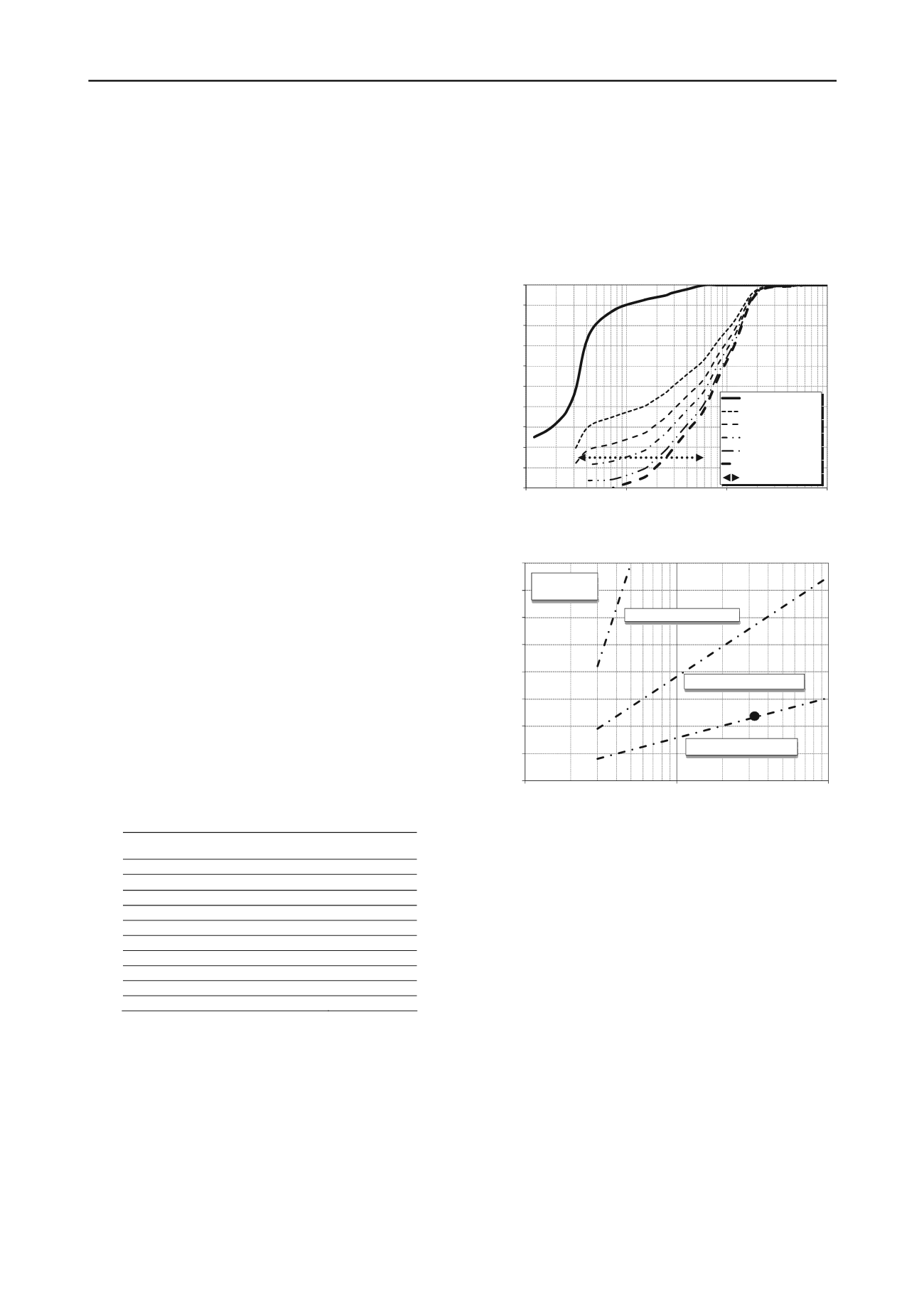
3322
Proceedings of the 18
th
International Conference on Soil Mechanics and Geotechnical Engineering, Paris 2013
dilatants and, consequently, their use represents a significant
risk.In reply to this claim, Perry (1991) says that the highly
erosive nature of the loess is well known. Accordingly, to avoid
the dam core piping formed by silty soil, it requires the
placement of an appropriate filter downstream. Thus Ririe Dam,
built 35 kilometers of Teton Dam, has built a loess core and
designed the appropriate filters, showing satisfactory
performance.
In Argentina, loessial silts have been used in several dams
and roadworks. The most important example is the Rio Hondo
Dam, built in the 1960s, regardless dispersion problems (Grandi
et al, 1961). The material used in this work is a silt with a clay
content between 15 and 20% and plasticity index of 6%
(Moretto et al, 1963). In structural revisions made several
decades after its construction, it was concluded that the dam has
adequate hydraulic behavior. Buraschi and Pujol (1999) have
discussed the possibility of internal erosion in this dam.
This paper discusses the hydraulic stability sandy silt soil
type, in the compacted state. The material is subjected to
erosion situations under the application of several hydraulic
gradients. For the protection of silt, it has been used natural
filters with different particle sizes. One of the most discussed
issues at the international level is the testing methodology. The
authors have optimized an analysis methodology based on the
use of a filter cell. The results of the test campaign performed
with the technique developed by the authors of this publication
are presented.
2 COMPOSITION OF THE STUDY
2.1 Soil involved in testing
The characteristics of the soil tested in these studies have
been described by different authors, Reginatto (1970), Moll and
Rocca (1991). Loessial soils of central Argentina are formed
mainly by silt. The grain size composition comprising: sand
(2% to 10%), silt (40% to 80%), and clay (20% to 35%). The
composition is completed by calcium carbonate, variable
between 2% and 10%, which exists in the form of nodules,
called “toscas”, or precipitate in the contact between particles.
These soils are alkaline, with pH> 8.
The physical properties of the soil tested are shown in Table 1.
Table 1.Properties of base material used
Property
Value
Natural moisture (ω), (%)
12.7 - 20.7
Dry Unit Weight (
d
), (kN/m
3
)
12.3
Specific Gravity (Gs)
2.65
Liquid Limit (ω
l
), (%)
24.4
Plastic Limit (ω
p
), (%)
21.0
Plastic Index (PI), (%)
3.4
Particles< 4.50 mm, (%)
100.0
Fines < 0.075 mm, (%)
93.4
Clay< 0.002 mm, (%)
14.0
USCS Classification
ML
Through compaction tests yielded a value of 15.5% optimum
moisture and maximum dry unit weight of 17.6 kN/m
3
. To
simulate conditions of poor compaction, tests were conducted
with the application of 90% of the energy corresponding to
Standard Proctor test.
Fine grain sand was used as a base material for the
construction of the filter. This type has been called SP, as the
unified system. Zeballos et al (2010) have shown the unstable
behavior of the system formed by compacted loess and filter,
when it is formed only by sand. In the results presented in this
paper, using filters formed by a combination of sand and silt
loess, the filtration was measured. It has also been analyzing the
operation of the set soil - filter, both under transient and steady
flow. The mixtures tested as filters, have used combinations of
sand and silt with a share of sand: 60%, 75%, 85% and 95%,
relative to the total weight. The mixtures formed are presented
in Figure 1. In the same Figure, the range corresponding to 15%
pass filter (d
15f
%) frequently recommended, is presented. Each
of these mixtures was tested with the application of hydraulic
gradients in the order of 20, 40 and 80. Figure 2 shows the
location of the soil analyzed according to the classification of
Burenkova (1993).
0
10
20
30
40
50
60
70
80
90
100
0.01
0.1
1
10
Passing Porcentage [%]
Grain Dimensions [mm]
Silt
60%sand - 40% silt
75%sand - 25% silt
85%sand - 15% silt
95%sand - 5% silt
Sand
Recommended range
Figure 1.Particle size of the soils used in the study.
Base Soil
SILT
1.0
1.5
2.0
2.5
3.0
3.5
4.0
4.5
5.0
1
10
100
d90 / d60
d90 / d15
I - Suffusion Zone
II - NO Suffusion Zone
III - Suffusion Zone
IV - Artificial
Soils
Figure 2.Burenkova chart for characterizing the potential of suffusion.
Location of the studied silts
.
For the materials used in this study, it is possible to make the
following comments:
Burenkova graph, locates the soil base tested (loess silt), in
the limit of the erosive behavior.
Several filter mixtures tested has fines content greater than
that normally recommended for the treatment of these
problems, (not exceeding 5% of passing sieve 200).
2.2 Tests Performed
A filtration chamber of large dimensions has been designed.
The cylindrical chamber has a height of 500 mm with a span of
105 mm diameter. The chamber was constructed with
transparent plastic, which allows visual monitoring of the
filtration process. At its top, the chamber is connected with the
water injection system pressure. In its lower part is connected to
the flow registration system and containment system of solid
particles. The chamber used, in schematic form, is presented in
Figure 3.
In the upper part of the chamber is placed a granular material
(drain) to facilitate the distribution of incoming water to the
beaker. This allows the water to reach the probe evenly. The
soil tested is located below the drain. The height of the cylinder
is regulated depending on the applied hydraulic gradient. The


